Discover 20 hidden attractions, cool sights, and unusual things to do in Georgia. Don't miss out on these must-see attractions: Georgian State Museum of Theatre (Tbilisi), Svetitskhoveli Cathedral (Mtskheta) or Metekhi Church (Tbilisi).
Below, you can find the list of the most amazing places you should visit in Georgia.
Table of Contents
Georgian State Museum of Theatre, Tbilisi
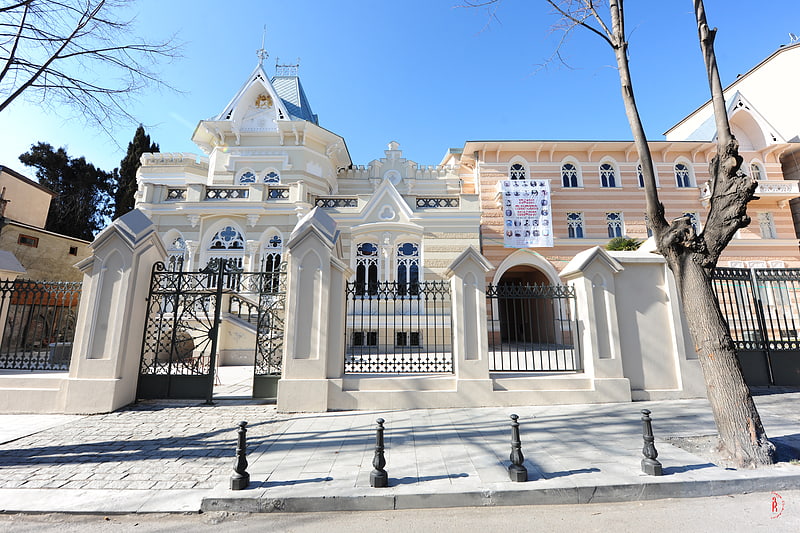
Art Palace of Georgia - Museum of Cultural History also referred to as Art Palace, is located in Tbilisi, Georgia. It is located on Kargareteli Street #6, and was the former Graph Oldenburg's Palace. The museum's exhibition halls are open daily from 10:30-18:00.
Until April 8, 2020, it was called the Georgian State Museum of Theater, Music, Cinema and Choreography. The name was changed according to the resolution of the Government of Georgia.[1]
Address: 6 Kargareteli St., 0112 Tbilisi
Svetitskhoveli Cathedral, Mtskheta
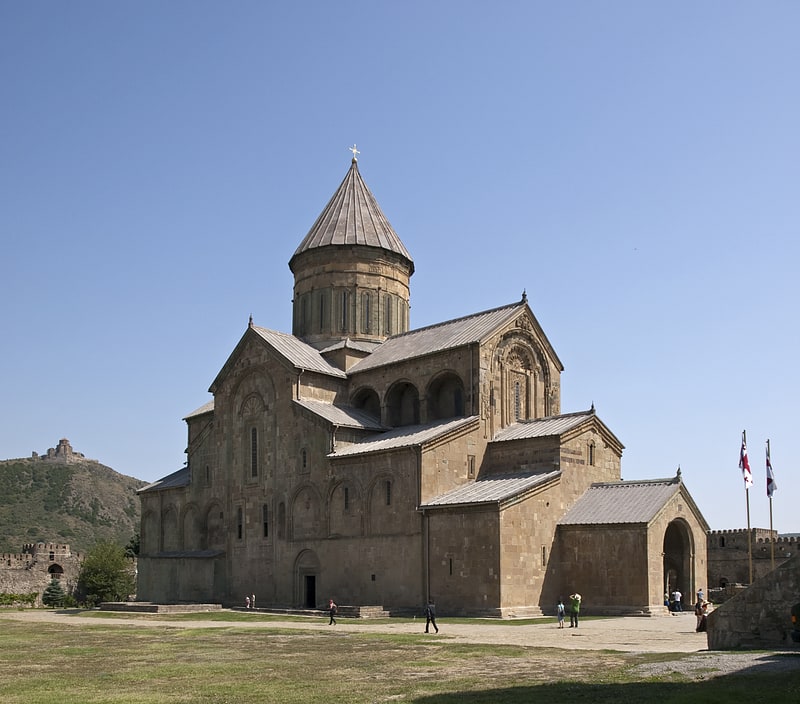
Also known as: სვეტიცხოველი
11th-century Eastern Orthodox cathedral. The Svetitskhoveli Cathedral is an Orthodox Christian cathedral located in the historic town of Mtskheta, Georgia, to the northwest of the Georgian capital Tbilisi. A masterpiece of the Early and High Middle Ages, Svetitskhoveli is recognized by UNESCO as a World Heritage Site. It is currently the second largest church building in Georgia, after the Holy Trinity Cathedral.
Known as the burial site of the claimed Christ's mantle, Svetitskhoveli has long been one of the principal Georgian Orthodox churches and is among the most venerated places of worship in the region. Throughout the centuries, the cathedral served as the burial place for kings. The present cross-in-square structure was completed between 1010 and 1029 by the medieval Georgian architect Konstantine Arsukisdze, although the site itself dates back to the early fourth century. The exterior archature of the cathedral is a well-preserved example of typical decorations of the 11th century.
Svetitskhoveli is considered an endangered cultural landmark; it has survived a variety of adversities, and many of its priceless frescoes have been lost due to being whitewashed by the Russian Imperial authorities.[2]
Address: Narekvavi-Mtskheta-Railway Station, Mtskheta
Metekhi Church, Tbilisi

Orthodox church in Tbilisi, Georgia. The Virgin Mary Assumption Church of Metekhi, known simply as Metekhi, is a Georgian Orthodox Christian church located on the left bank of the river Kura. It sits on the Metekhi Cliff opposite the old town of Tbilisi. Much of the existing structure dates back to the Middle Ages and was built between 1278 and 1289 AD under the reign of King Demetrius II of Georgia, although oral tradition traces Metekhi's origins further to the 5th century.[3]
Sameba Cathedral, Tbilisi
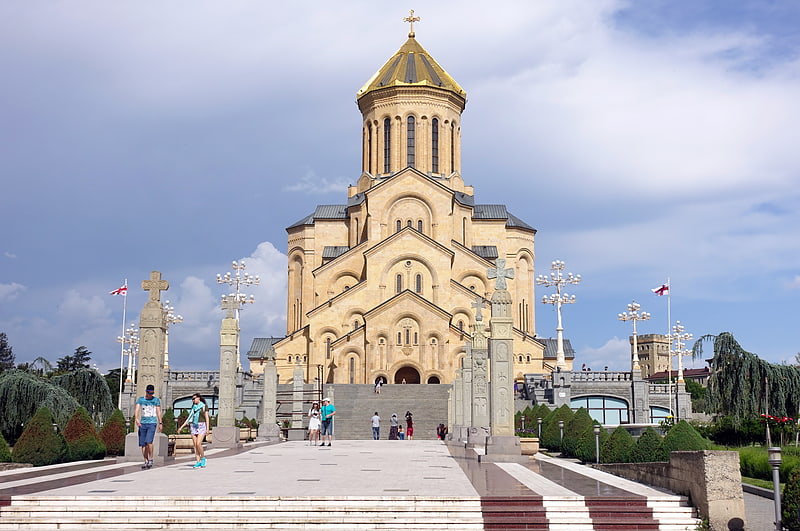
Also known as: წმინდა სამების საკათედრო ტაძარი
Georgian Orthodox compound built in 2004. The Holy Trinity Cathedral of Tbilisi, commonly known as Sameba, is the main cathedral of the Georgian Orthodox Church located in Tbilisi, the capital of Georgia. Constructed between 1995 and 2004, it is the third-tallest Eastern Orthodox cathedral in the world and one of the largest religious buildings in the world by total area. Sameba is a synthesis of traditional styles dominating the Georgian church architecture at various stages in history and has some Byzantine undertones.[4]
Address: Elia Hill, Tbilisi
Jvari Monastery, Mtskheta
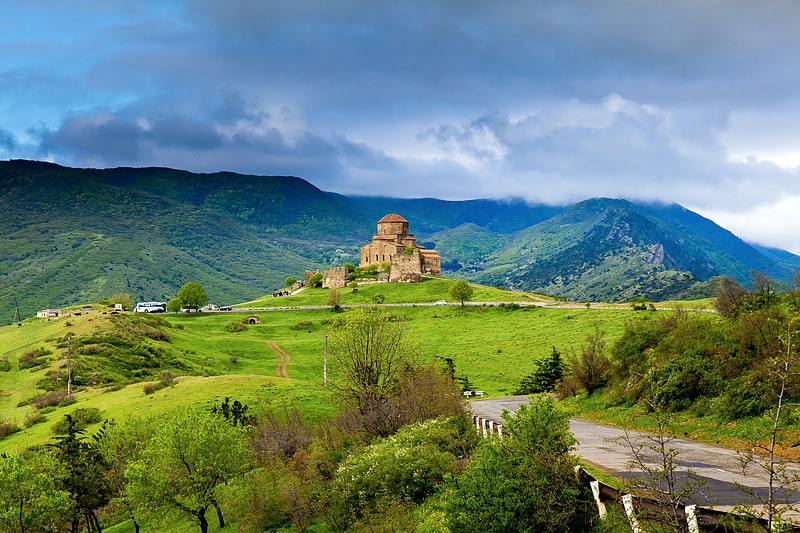
Also known as: ჯვარი
6th-century mountaintop monastery. Jvari Monastery is a sixth-century Georgian Orthodox monastery near Mtskheta, eastern Georgia. Jvari is a rare case of an Early Medieval Georgian church that has survived to the present day almost unchanged. The church became the founder of its type, the Jvari type of church architecture, prevalent in Georgia and Armenia. Built atop of Jvari Mount, the monastery is an example of harmonious connection with the natural environment, characteristic to medieval Georgian architecture. Along with other historic structures of Mtskheta, the monastery was listed as a World Heritage Site by UNESCO in 1994.[5]
Address: near Mtskheta, Mtskheta
Gelati Monastery, Kutaisi
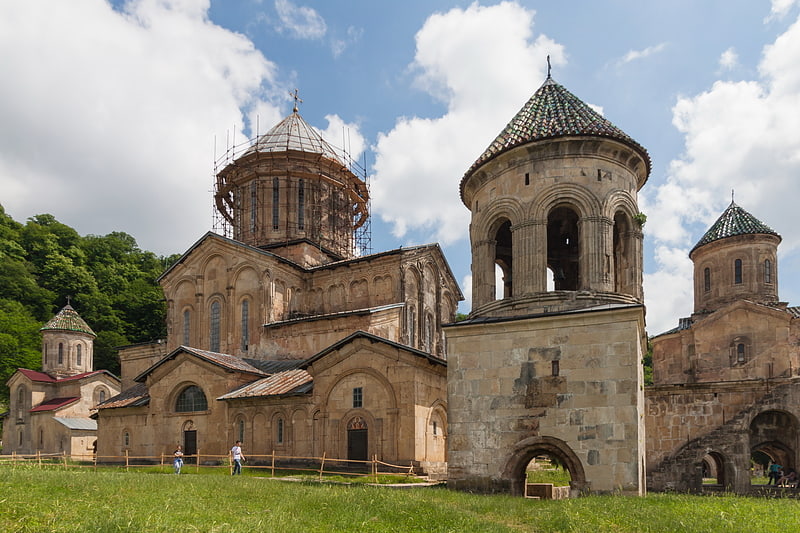
Also known as: გელათის მონასტერი
Scenic medieval complex with frescoes. Gelati is a medieval monastic complex near Kutaisi in the Imereti region of western Georgia. One of the first monasteries in Georgia, it was founded in 1106 by King David IV of Georgia as a monastic and educational center.
The monastery is an exemplar of the Georgian Golden Age and a gold aesthetic is employed in the paintings and buildings. It was built to celebrate Orthodox Christian faith in Georgia. Some murals found inside the Gelati Monastery church date back to the 12th century. The monastery was inscribed as a UNESCO World Heritage Site in 1994 because of its outstanding architecture and its importance as an educational and scientific center in medieval Georgia.[6]
Address: Road to Gelati Monastery, 4600 Kutaisi
Zedazeni Monastery, Mtskheta
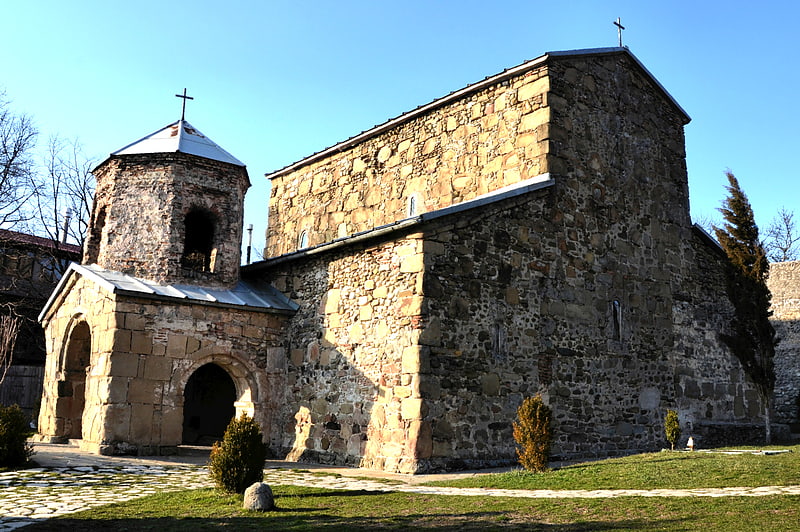
Monastery in Georgia. Zedazeni Monastery is a Georgian Orthodox monastery, located on the Zedazeni mountain the hills of Saguramo, northeast to Mtskheta and to the east side of the Aragvi River.
The monastery was founded by Saint John, one of the Holy Assyrian Fathers of Georgia whose mission was to strengthen Christianity in the region.[7]
Bagrati Cathedral, Kutaisi
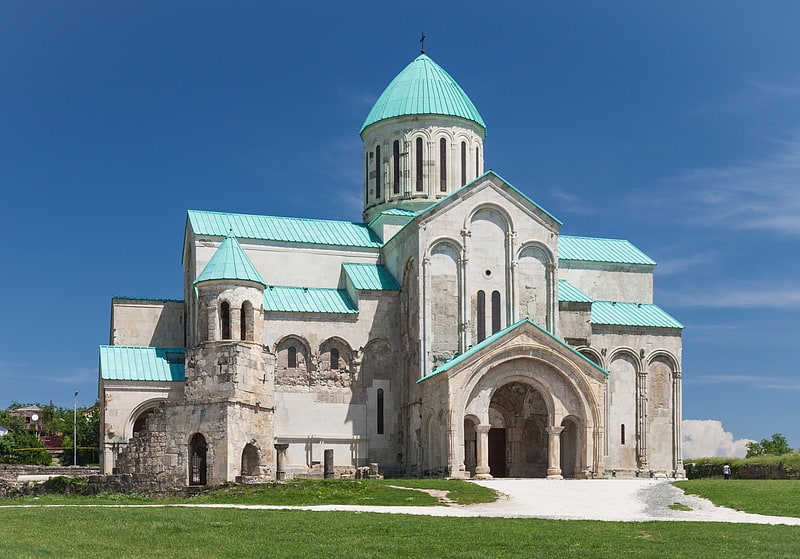
Also known as: ბაგრატის ტაძარი
Reconstructed 11th-century cathedral. The Cathedral of the Dormition, or the Kutaisi Cathedral, more commonly known as Bagrati Cathedral, is an 11th-century cathedral in the city of Kutaisi, in the Imereti region of Georgia. A masterpiece of medieval Georgian architecture, the cathedral suffered heavy damage throughout centuries and was reconstructed to its present state through a gradual process starting in the 1950s, with controversial conservation works concluding in 2012. These works prompted UNESCO to remove the Cathedral from its list of World Heritage sites. A distinct landmark in the scenery of central Kutaisi, the cathedral rests on the Ukimerioni Hill.[8]
Address: Bagrati Street, 4600 Kutaisi
New Athos Cave, New Athos
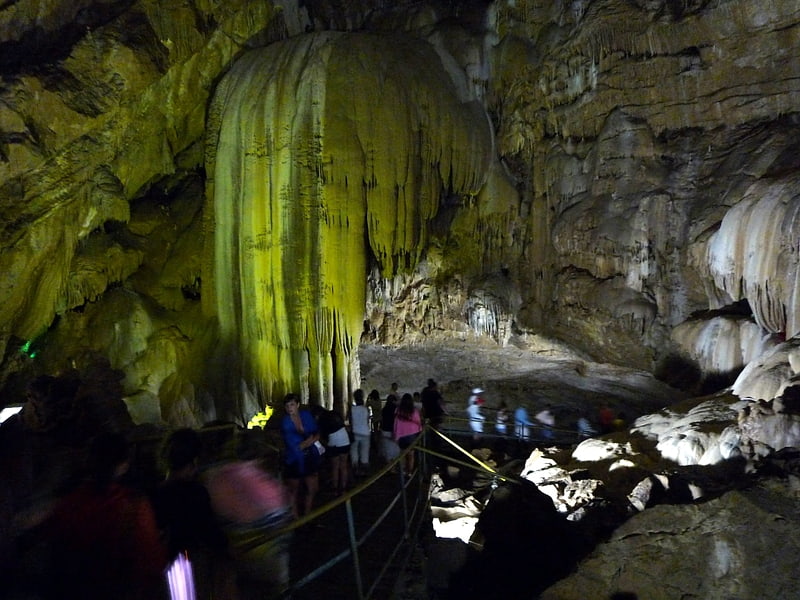
Also known as: ახალი ათონის მღვიმე
Cave in Asia. The New Athos Cave also Novoafonskaya, Novy Afon Cave, or New Afon Cave is a karst cave in the Iverian Mountain in Abkhazia near the city of New Athos.[9]
Motsameta Monastery, Kutaisi
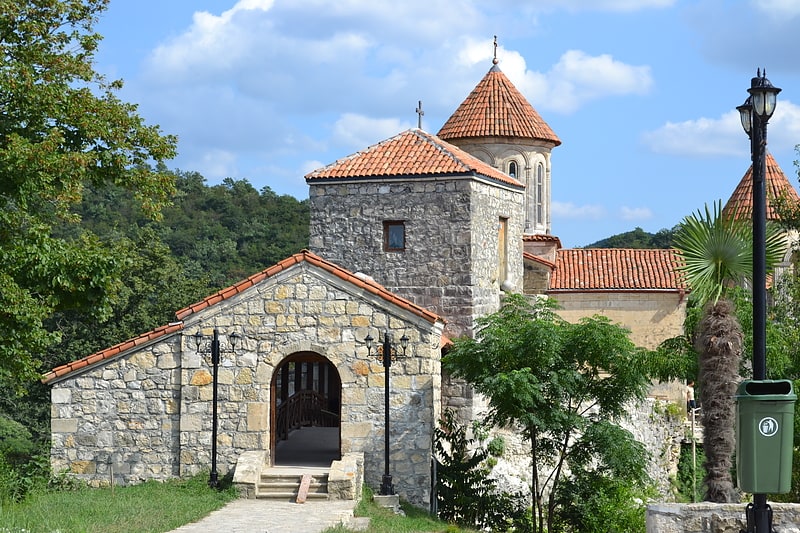
Monastery in Georgia. Motsameta also known as Motsameta monastery is a complex of monasteries at the Imereti region, approximately 6 km northeast of the center of Kutaisi, Georgia. The monastery is picturesquely located on the cliff of a promontory in the curve of the Ckalcitela river, a tributary of the Rioni river.[10]
Gonio Fortress, Batumi

Also known as: გონიოს ციხე
Roman ruins of an ancient fortress. Gonio fortress, is a Roman fortification in Adjara, Georgia, on the Black Sea, 15 km south of Batumi, at the mouth of the Chorokhi river. The village sits 4 km north of the Turkish border. Its name was connected with the myth of Medea and her brother Absyrtus.
The oldest reference to the fortress is by Pliny the Elder in the Natural History (1st century AD). There is also a reference to the ancient name of the site in Appian’s Mithridatic Wars (2nd century AD). In the 2nd century AD it was a well-fortified Roman city within Colchis. The town was also known for its theatre and hippodrome. Procopius, writing in the 6th century, speaks of the remains of its public buildings as proving that it was once a place of some importance.
It later came under Byzantine influence. The name "Gonio" is first attested in Michael Panaretos in the 14th century. In addition, there was a short-lived Genoese trade factory at the site. In 1547 Gonio was taken by the Ottomans, who held it until 1878, when, via the San-Stefano Treaty, Adjara became part of the Russian empire. In the fall of 1647, according to Evliya Çelebi, Gonio was captured by a Cossack navy of 70 chaikas, but quickly recovered by Ghazi Sidi Ahmed, ruler of the Tortum sanjak, with a force of 1,000 Turks and 3,000 "Mingrelians".
The grave of Saint Matthias, one of the twelve apostles, is believed to be inside the Gonio fortress. However, this is unverifiable as the Georgian government currently prohibits digging near the supposed gravesite. Other archaeological excavations are however taking place on the grounds of the fortress, focusing on Roman layers.
Gonio is currently experiencing a tourism boom. Most tourists come from Tbilisi in the summer months to enjoy beaches that are generally regarded as cleaner than Batumi's beaches (located 15 km to the north).[11]
Address: Left Bank of the River Chorokhi, 384542 Gonio
Batumi Cathedral of the Mother of God, Batumi
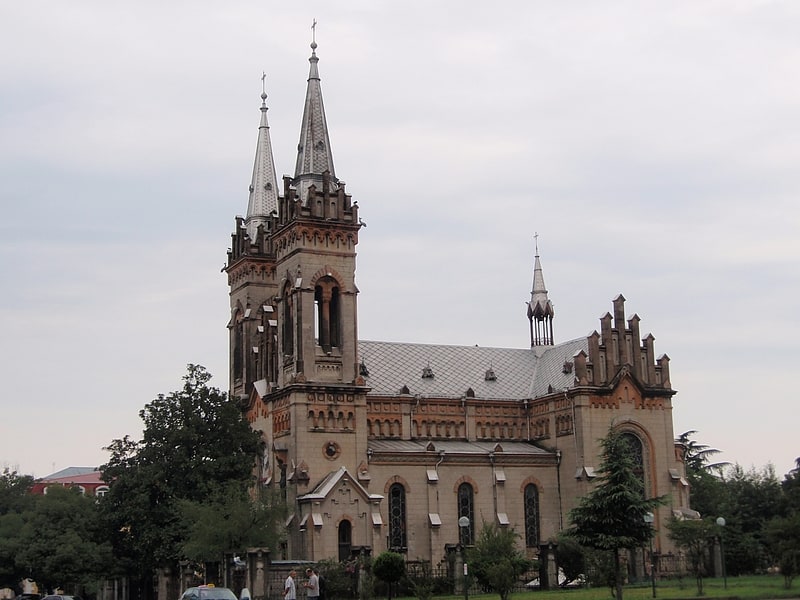
Also known as: ბათუმის ღვთისმშობლის სახელობის ეკლესია
Cathedral in Batumi, Georgia. The Church of the Mother of God in Batumi is a Georgian Orthodox cathedral, originally built as a Catholic church early in the 1900s. A Gothic Revival design, the church is located in the Black Sea city of Batumi in Georgia's autonomous republic of Adjara.
The church was built as a Roman Catholic church through the sponsorship of the Zubalashvili brothers, Georgian Catholic businessmen, between 1898 and 1902. During the Soviet period the church was closed and converted into a high-voltage laboratory. In 1989 the church was transferred to the Georgian Orthodox Church. The Roman Catholics in Batumi now use the Church of the Holy Spirit, a modern structure consecrated in 2000.[12]
Sukhumi botanical garden, Sukhumi
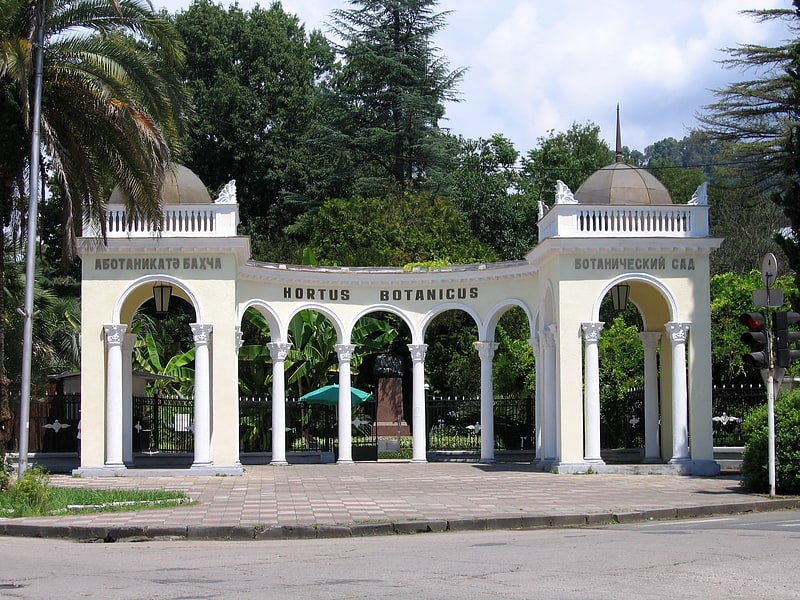
Also known as: სოხუმის ბოტანიკური ბაღი
Botanical garden with tropical plants. The Sukhumi Botanical Garden is one of the oldest botanical gardens in the Caucasus. It was founded in 1840 as Sukhum-Kale Military-Botanical Garden by the head of the Russian Black Sea fortification line Nikolay Raevsky with the purpose of the introduction of new plants in the region. It was ravaged by Turkish forces in 1853–55 and 1877–78 in the course of the Russo-Turkish wars. The garden was transferred to civil authorities in 1889 and the restoration of the plantings was begun in 1894.
It continued to develop during the Soviet rule and it was finally transformed into the research institute of botany of the Academy of Sciences. More than 4,500 species were collected in the garden, including 1,200 tropical ones.
The garden suffered greatly during the Georgian-Abkhazian War between (1992–1993).[13]
Cathedral, Sukhumi
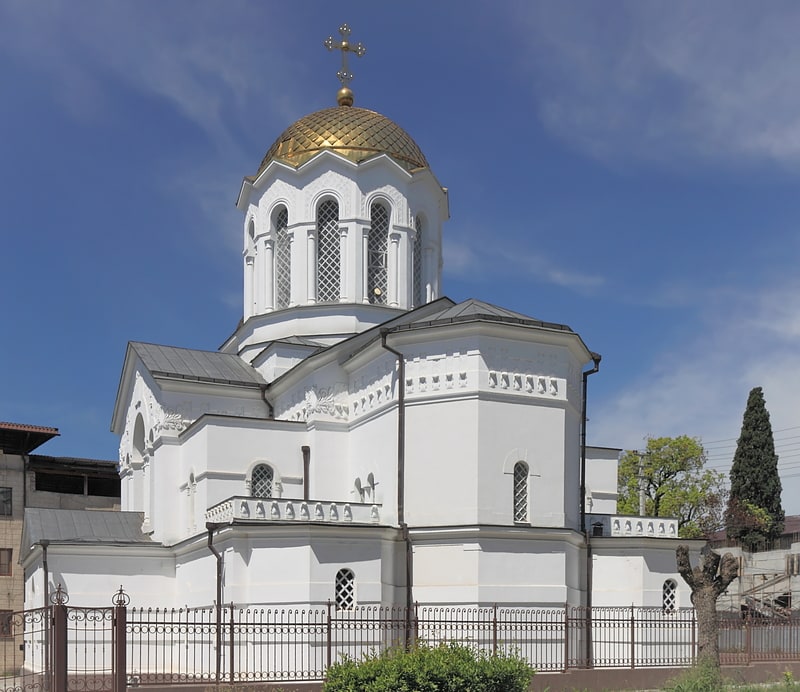
The Sukhumi Cathedral of the Annunciation is an Eastern Orthodox church in the city of Sukhumi, the capital of Abkhazia, an entity in the South Caucasus with a disputed political status.
The cathedral was built in a Neo-Byzantine fashion by Sukhumi's then-vibrant Greek community between 1909 and 1915. It was then consecrated in the name of St. Nicholas and was, therefore, popularly referred to as Greek Nicholas Church. In the 1940s, after the expulsion of most of local Greeks by the Soviet government under Joseph Stalin, the church passed to the Georgian Orthodox Church as a replacement for its former diocesan cathedral church demolished by the Soviet authorities about a decade earlier. It was reconsecrated in the name of Annunciation and remained one of the few functioning churches on the territory of autonomous Abkhazia throughout the Soviet period. In the 1980s, the church was significantly refurbished and its premises expanded under the Georgian Orthodox metropolitan bishop David Chkadua.
As a result of the War in Abkhazia (1992–1993) and expulsion of ethnic Georgian clergy from Abkhazia, the church was left to the guidance of ethnically Abkhaz priest of the Georgian Orthodox Church, Vissarion Apliaa, who made some renovation on the church building with the help of the Russian church authorities in 2011. Apliaa declared severance of ties with the Georgian church and began to style himself as the leader of independent Abkhazian Orthodox Church, although the former remains canonically unrecognized within the Orthodox world and the Abkhaz Orthodox clerical community itself straddles division. In 2011, the de facto Abkhaz government transferred 38 churches, cathedrals and monasteries perpetually into the care of the Abkhazian Orthodox Church. From the point of the Georgian government, the church is part of cultural heritage located in the Occupied Territories of Georgia.[14]
Address: Abaza St, Sukhumi
Chacha Tower, Batumi
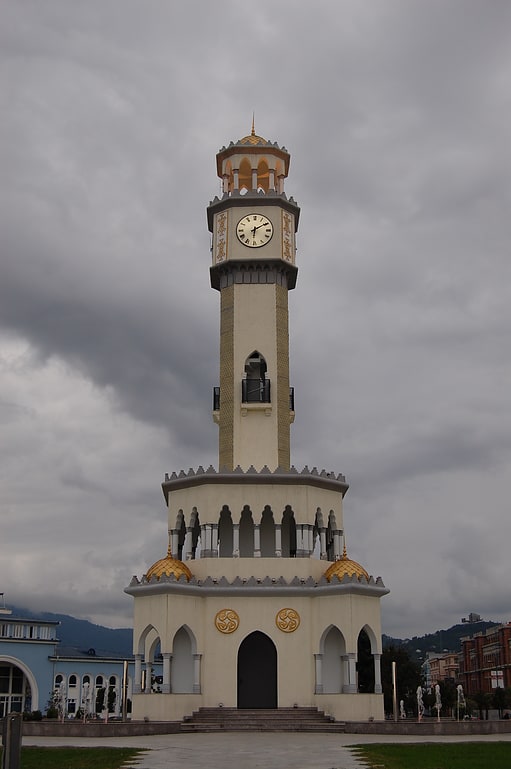
Tower in Batumi, Georgia. Chacha Tower is a clock tower located in Batumi, Georgia. It was built in 2012 by the city council with a cost of one million Georgian laris. The tower is 25 m high and has four fountains. It is a replica of the Clock Tower in İzmir, Turkey. Georgian chacha comes out of the fountains of the tower instead of water. The tower hosts a tourism information center.
As of 2015, the chacha fountain was reportedly nonfunctioning.[15]
Address: Batumi, Batumi, Georgia
Anacopia Fortress, New Athos
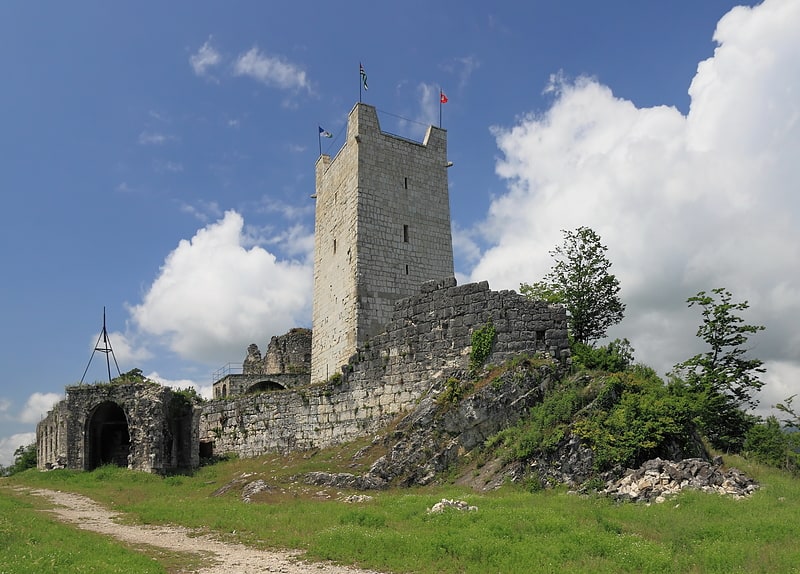
Also known as: ანაკოფია
Historical place. Anacopia Fortress is an ancient military citadel in New Athos in the disputed Republic of Abkhazia, located some 22 km by road along the coast from Sukhumi. The site, approximately 450 × 150 meters in dimensions, is located a mile or so inland, at the top of the Iverian Mountain. It is the most complete surviving building of ancient Anacopia, the former capital of the Kingdom of Abkhazia.[16]
Address: Anokopiyskaya Mountain, New Athos
Stalin Museum, Gori
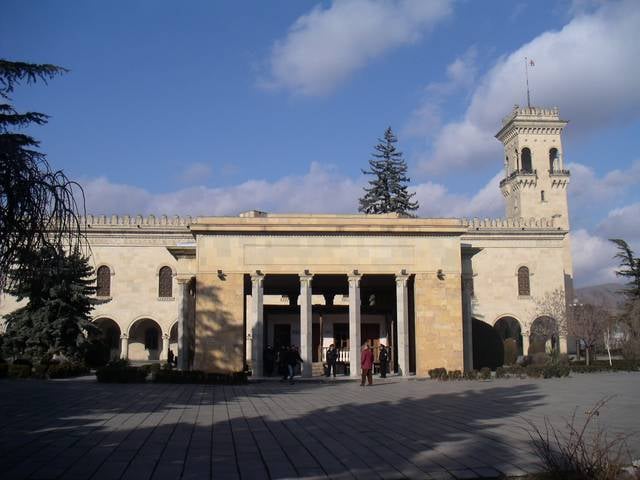
Also known as: იოსებ სტალინის სახელმწიფო მუზეუმი
Memorial hall for the namesake dictator. The Joseph Stalin Museum is a museum in Gori, Georgia dedicated to the life of Joseph Stalin, the leader of the Soviet Union, who was born in Gori. The Museum retains its Soviet-era characteristics.[17]
Address: 32 Stalin Ave, 1400 გორი
Gori Fortress, Gori
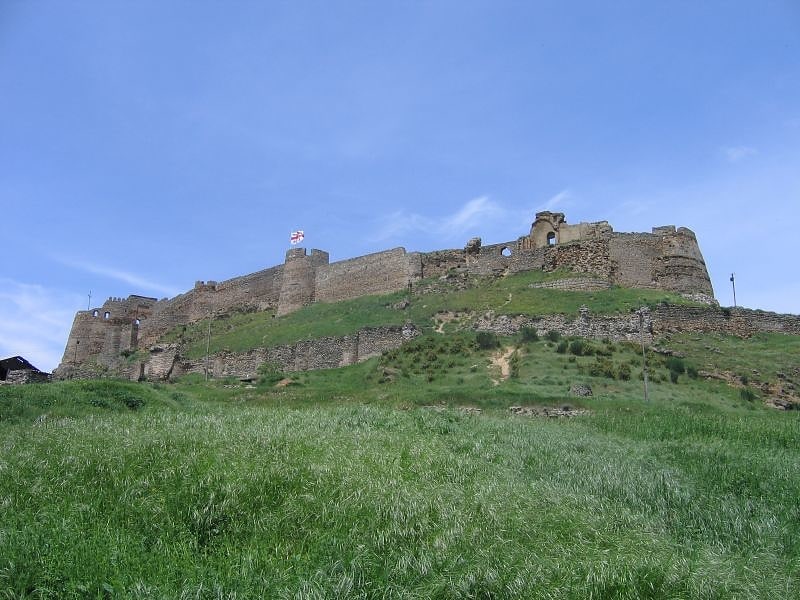
Also known as: გორის ციხე
Fortress in Gori, Georgia. Gori Fortress is a medieval citadel in Georgia, situated above the city of Gori on a rocky hill.
Standing on the hilltop, the fortress’s outlines follow the natural relief, hence the irregular shape. The inner fortifications occupy the entire plateau, from which the walls descend towards the road along the western slope. Originally, the walls reached the river below and the water had to be diverted through a tunnel, but the river has retreated since.
The fortress first appears in records from the 13th century, but archaeological evidence shows that the area had already been fortified in the final centuries BCE. The fortress was of major strategic importance, given its dominant position guarding a regional trade route, and accommodated a large garrison. In the 16th century the Ottomans captured it to overawe Tbilisi. In 1598 the Georgians, lead by their king Simon I, besieged it for nine months to no avail; in 1599 they feigned relieving the siege for Lent and then launched a surprise night attack to regain control over the citadel. The fortress continued to change hands between the Georgians and the Persians in the 17th century.
The citadel acquired its present-day form under the Georgian kings Rostom of Kartli in the 1630s and Erekle II in 1774. Following its completion, King Rostom asked the Italian missionary Cristophoro Castelli, who lived in Gori, to draw the fortress. His stunning illustration from approximately 1642 is a valuable historical document. After the Russian annexation of Georgia in 1801, the fortress was garrisoned by a Russian grenadier battalion, but its importance gradually declined and the fortifications went defunct. The city plan of 1824 shows the citadel, the city on the hill slopes and a moat encircling both. The British Encyclopædia Metropolitana reported in 1845:
At the foot of a chain of low sandstone hills stands the Town and Fortress of Gori, (perhaps the Gursenna of Strabo) the next place in magnitude and importance to Tiflis. The Castle, an oblong, 200 paces in length, placed sixteen fathoms above the level of the Liakhvi, running at the foot of the hill on which it stands, is now abandoned, a Chapel in its South-Eastern angle being the only part in use.
Gori Fortress was significantly damaged by an earthquake in 1920. The best preserved structure is Tskhra-kara ("the Nine-gated"), facing to the west and adjoined by supplementary walls on the south and east.[18]
Gori City Hall, Gori

Gori City Hall is an administrative building of Gori, Georgia, a city in eastern Georgia, which serves as the regional capital of Shida Kartli.[19]
Kelasuri Wall, Sukhumi
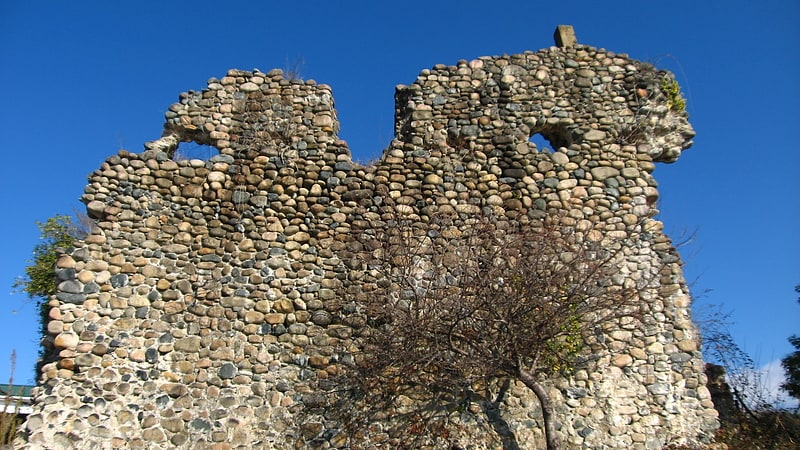
Also known as: კელასურის კედელი
The Kelasuri Wall or Great Abkhazian Wall is a stone wall located to the east of Sukhumi in Abkhazia, Georgia. The exact time of its construction is not known; several dates ranging from antiquity to the 17th century were suggested, although more recent works have provisionally favoured construction in the 6th century AD. The wall featured about 300 towers, most of them now entirely or largely ruined.[20]